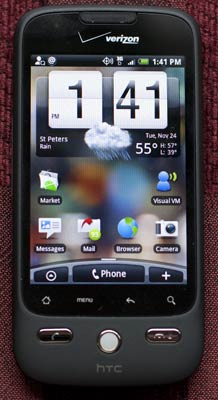Gifts of Christmas 2009: Eris is Not Just "Droid Lite"
If you weren’t paying too close of attention last month, you might have missed the HTC Droid Eris in all the commotion over the Motorola Droid. Despite both being “Droids” and both landing at Verizon on the same November day, the Droid Eris comes from a different manufacturer, offers different features and comes at a lower price. Last minute Christmas shoppers take note: the Eris deserves your attention.
In the last month, Open for Business has looked at two recent HTC phones, the Imagio and the Pure. They are both fine phones, but the conclusion we reached on each was the same: they are tied to a platform that is outdated and with a cloudy future, Windows Mobile. On the other hand, the Eris is Android-based and hence is a device with a much more forward looking foundation.
The better known Droid received our Editor’s Choice award in November, and it deserved the award: the first Android 2.0 phone brought with it a very satisfying piece of hardware, a beautiful screen and Google Maps Navigation (free, and amazingly well done, GPS turn-by-turn navigation, which we discussed in our Droid review). The latter point is the clincher for the Droid that makes it one of the most interesting smart phones available right now. There is little doubt that the Droid is worthy of being the big red carrier’s flagship phone and it is certainly capable as the arch nemesis to the iPhone.
Enough about the Droid – where does the Droid Eris fit into this puzzle? Not necessarily where it might seem obvious at first glance.
 |
|
The home screen on the Droid Eris provides an overview of current weather conditions and quick access to frequently used apps. |
While cheaper than the Droid, it actually comes with some nice touches the Droid lacks. For example, while the Eris does not come with a hardware keyboard, the onscreen keyboard was one of the best we’ve used, perhaps the best onscreen keyboard on a non-Apple device. The much-lamented absence of multi-touch pinch-and-zoom gestures in the Droid and other Android phones is also solved here; as small as it may sound, web browsing on a mobile device is made so much easier and more practical with this simple addition that its absence on the Droid and presence on the Droid Eris is not something to simply be overlooked.
The Eris also adds a conveniently located little trackball directly below the screen. While the Eris is focused on touch input, much like the iPhone, the trackball makes for a good compliment to the touch screen. This alternative input method proved much more useful than we first expected, providing a tool to make very precise movements or scroll through pages in a one handed fashion.
Like HTC’s Windows Mobile phones, the Eris benefits from HTC’s tasteful and useful user interface additions. These start with the handy location aware clock and weather forecast on the front screen. The forecast changes based on one’s location. Tap on the clock and the device’s world clock launches; tap on the weather forecast and a weather application that is nearly the mirror image of HTC’s TouchFLO 3D Windows Mobile weather app loads. (The Motorola Droid, on the other hand, does not come with a built in weather application at all, oddly.)
While HTC’s Sense UI additions to Android are not quite as mature feeling as the company’s TouchFLO 3D skin for Windows Mobile, Sense UI is still extremely good. Better yet, unlike TouchFLO 3D, it blends well with the rest of the Android operating system; as such, instead of feeling like an attempt to place a (very good) façade over an aging operating system (as TouchFLO 3D does on the Imagio, Pure, Touch HD2 and so on), Sense UI blends with the rest of Android beautifully to create something that is Android, but better. In fact, while we noted with the Droid that Android still feels a little rough, that roughness felt like it was progressing towards a fine polish with the Eris.
Beyond the fine weather and stock apps, other additions courtesy of Sense UI include quite a few extra home screens for holding application icons and a large variety of well designed widgets (either HTC’s own Sense UI ones or standard Android widgets). HTC also has its own take on social network integration, ala Android 2.0, included and a fascinating little app for marking out the GPS location of interesting places.
The Droid Eris also surpasses the Droid in camera quality. While the Droid brings a disappointing camera along for the ride in an otherwise impressive piece of hardware, the cheaper Eris offers what amounts to a very good cell phone camera. Picture quality was not quite up to that of the iPhone 3GS, which produced pictures with less noise in the same light, but color accuracy was similar and close to that of what we might expect from a low-end point and shoot.
 |
|
Close ups of a still life on the Eris, Droid and iPhone 3GS, respectively. Inset on the top right of each sample is a 100% crop. |
About the only major glitch we encountered with the Eris was that it had a strong preference for defaulting to POP3 for e-mail account configuration if the server offered it. This is an unfortunate design decision since POP3 is not particularly practical on a smartphone. We also noticed that when using POP3 on the Eris, e-mails sometimes showed as already read on IMAP clients, even when they had not been. Once the Eris’s e-mail was configured manually to use IMAP, however, everything went smoothly.
The Eris is a very fine smartphone. When we first tested it, we expected to be able to say it had one very big disadvantage in relation to the more expensive Droid: the lack of Google Maps Navigation. Yet, this is no longer so. Verizon has committed to releasing a Google Maps Navigation compatible version of Android as an update for the Eris. Verizon’s commitment could mean the Eris will get Android 1.6 and not 2.0, but even if that were so, with Google Maps Navigation support, the Eris will definitely have the main feature we wanted to see on it that was lacking in its Android 1.5 firmware; many of the other features in Android 2.0 are already offered in some variation via HTC’s Sense UI.
With this impending update in mind, we think the Eris is actually in many ways even better than the Droid itself. The only real disadvantages to HTC’s phone in comparison to the Droid are the smaller screen and slower processor. Depending on your needs these may or may not be issues at all. The processor speed is occasionally apparent in web page rendering, but for many sites, there was no discernable difference in loading speed.
For a phone that so ably holds up against its better known cousin and even the iPhone, the Droid Eris deserves more attention than it has gotten so far. Rather than being a step down from the more expensive Droid, we think it would be better to look at the Droid Eris as a very capable alternative to the Droid. The Eris is certainly not a phone to be looked over for gift giving this year… or for picking up after Christmas for yourself (HTC/Verizon, $99, www.vzw.com).
| The Droid Eris is one of our Christmas Gift Editor's Choice products for 2009, denoting that we found it to be of the highest quality and value. Open for Business Editor's Choice products are believed by OFB to be at the top of their product segment. |  |
Join the Conversation
Pingback: Twitter Trackbacks for Gifts of Christmas 2009: Eris is Not Just "Droid Lite" - OFB.biz: Open for Business [ofb.biz] on Topsy.com